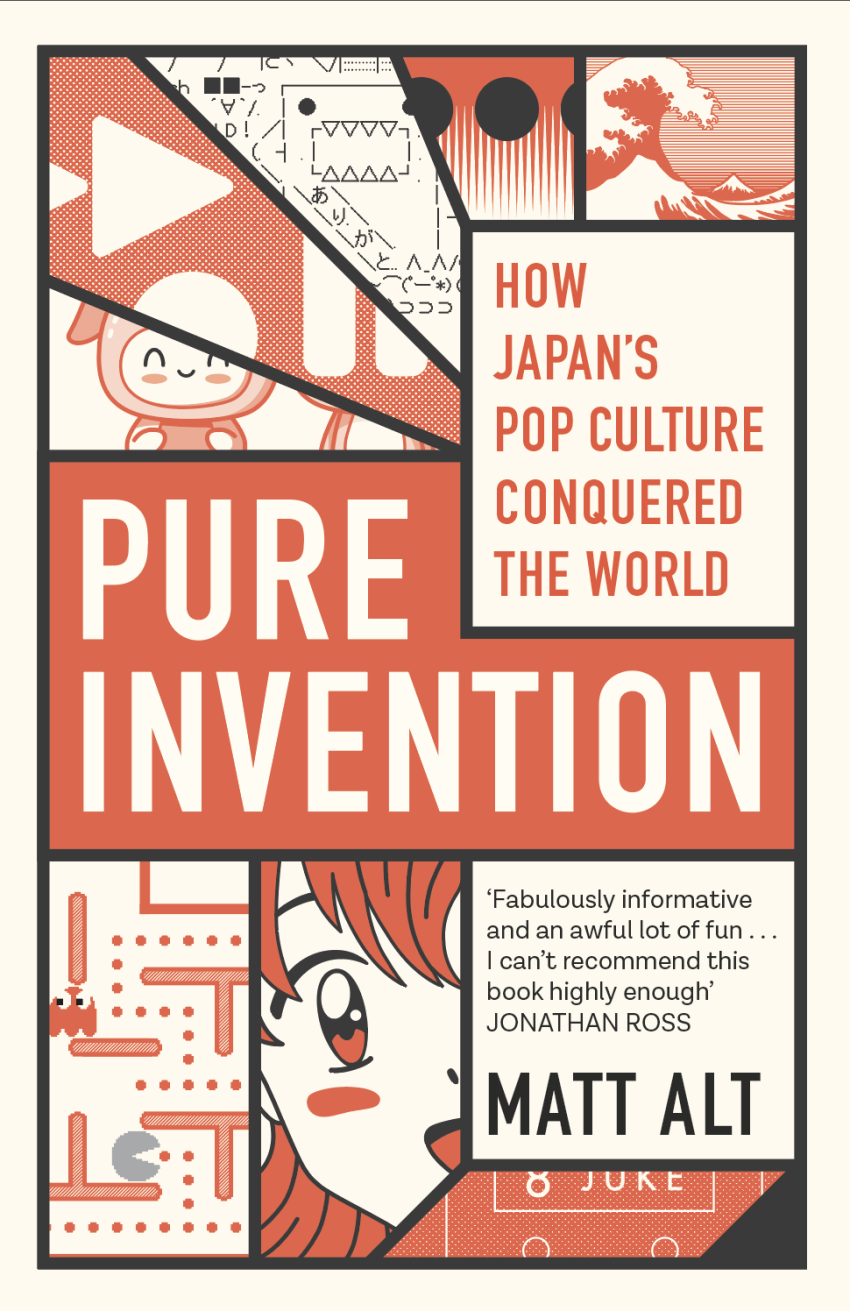Books: Pure Invention
June 12, 2020 · 0 comments
By Jonathan Clements.
 Matt Alt’s Pure Invention: How Japan’s Pop Culture Conquered the World is a work of startling originality. Like the dozen inventions and creations it profiles, it takes already-familiar technology and repurposes it to new and innovative ends, using everyday objects as springboards to discuss the peculiarities of Japanese culture and the global impact of deceptively simple devices. It is nothing less than a post-war history of Japan, told through its export successes in toys, games and media, hardware and software.
Matt Alt’s Pure Invention: How Japan’s Pop Culture Conquered the World is a work of startling originality. Like the dozen inventions and creations it profiles, it takes already-familiar technology and repurposes it to new and innovative ends, using everyday objects as springboards to discuss the peculiarities of Japanese culture and the global impact of deceptively simple devices. It is nothing less than a post-war history of Japan, told through its export successes in toys, games and media, hardware and software.
Alt takes as his entry point the 19th century wave of japonisme that gave us The Mikado and Oscar Wilde’s put-down of oriental obsessions, that “the whole of Japan is pure invention,” and John Foster Dulles’ condescending post-war assurance that “the Japanese don’t make anything we want.” But far from being yet another catalogue of fads and trends from the east, this is a serious account of something far more wide-ranging – the story of how Japanese creatives “redefined what it meant to be human” over the course of the 20th century, proving Dulles repeatedly wrong with the invention of “gloriously weird but strangely necessary” items, such as the Walkman, the Game Boy and Hello Kitty.
 It’s the toy manufacturer Matsuzo Kosuge who finds himself in Kyoto, the last city standing after the war, ransacking US Army trash heaps for tin cans, which he can turn into the must-have toy of 1946, a toy jeep. Originally intended for the domestic market, by 1947 Japanese toy cars are being sold back in the United States – from the very start, Japan’s toy culture has been one of its most vibrant and lucrative exports to the outside world. British toy companies, angry at the competition, had “Japanese” products banned from toy fairs in 1959. And yet, the all-American Barbie was made in Japan, dressed in clothes sewn by legions of Japanese seamstresses.
It’s the toy manufacturer Matsuzo Kosuge who finds himself in Kyoto, the last city standing after the war, ransacking US Army trash heaps for tin cans, which he can turn into the must-have toy of 1946, a toy jeep. Originally intended for the domestic market, by 1947 Japanese toy cars are being sold back in the United States – from the very start, Japan’s toy culture has been one of its most vibrant and lucrative exports to the outside world. British toy companies, angry at the competition, had “Japanese” products banned from toy fairs in 1959. And yet, the all-American Barbie was made in Japan, dressed in clothes sewn by legions of Japanese seamstresses.
When it comes to the “empty orche[stra]” – kara-oke – Alt incisively notes its invention on multiple occasions, as entrepreneurs unaware of each other’s existence independently stumble upon ideas for using recorded music as backing tracks for pub-singers. He tracks down Shigeichi Negishi, whose Sparko Box is one of the prime contenders for being the first real karaoke machine, although the term karaoke was shunned at first for sounding a bit too much like the word in Japanese for coffin.
Alt lays the catalyst for the invention of the karaoke machine in Japan as a specific Japanese cultural institution – the tedium and misery of the office salaryman, dragged off on interminable works outings and searching for a drunken entertainment outlet with sozzled colleagues and indulgent bar-girls. Like the ever-widening field of view of Osamu Tezuka’s Jumping, Alt scales up and out from the humble karaoke machine to the entire ecosystem that spawned it – expense-account piss-ups, hostess bars and “Turkish” brothels, but also the very infrastructure of the Japanese metropolis, the sunakku bars that serve desultory nibbles in order to qualify as late-opening “restaurants”, and the efficient train system that ensures none of these munted wage-slaves will need to drive home.
“We’re losing the art of bar conversation,” wrote the sci-fi author Ryo Hanmura. “Now everybody just sits there with their brains turned off, waiting for their turn to sing.”
It’s not long before Osamu Tezuka appears, refreshingly presented within the context of many other movers and shakers of early manga – still a crucial figure, still a genius, but also troubled by the rivalry from the new-fangled gekiga comics for adults. He throws himself into the chance to work on animated features but, again, Alt refuses to believe the hype, pinpointing Tezuka’s move into animation as a reaction to what he regarded as poor treatment at the hands of the Toei studio. He frames the story of the rise of Astro Boy in terms of the budgetary restrictions on limited animation, as Tezuka wilfully prices his cartoon far below the cost of making it.
“The beloved hallmarks of Japanese animated fare,” writes Alt, “the striking of theatrical poses, the lingering freeze-frames, the limited ranges of motion – evolved from desperate cost-saving workarounds into the key factors that distinguish anime from content produced in other lands. But they are more than stylistic flourishes. They are the direct result of that fateful choice Tezuka made so many decades ago.”
 Hello Kitty, in Alt’s hands, is a chance not just to examine the story of that famous London girl who is not a cat (no, really), but also the history and evolution of the term kawaii, from its first documented appearance in a 1914 flyer, through the development of Donkey Kong and Super Mario. Alt insightfully files these Nintendo creations as branches of the “cute” tree, in contention with the more aggressive imagery in American video games then-popular, such as Missile Command. But Hello Kitty also plays a role in the notorious story of enjo kosai “compensated dating,” as a scandalised designer from Sanrio promises a posse of schoolgirl prostitutes that she will design an affordable Hello Kitty purse if they stop banging old men for the cash to buy a Louis Vuitton bag.
Hello Kitty, in Alt’s hands, is a chance not just to examine the story of that famous London girl who is not a cat (no, really), but also the history and evolution of the term kawaii, from its first documented appearance in a 1914 flyer, through the development of Donkey Kong and Super Mario. Alt insightfully files these Nintendo creations as branches of the “cute” tree, in contention with the more aggressive imagery in American video games then-popular, such as Missile Command. But Hello Kitty also plays a role in the notorious story of enjo kosai “compensated dating,” as a scandalised designer from Sanrio promises a posse of schoolgirl prostitutes that she will design an affordable Hello Kitty purse if they stop banging old men for the cash to buy a Louis Vuitton bag.
So much of Japanese pop culture, of course, returns ultimately to anime, as does Alt in a later chapter that outlines the creation of an audience of adult anime fans, first glimpsed at the riotous premiere event of the first Gundam movie, where Yoshiyuki Tomino made his declaration of anime’s “new century.” His return to anime encompasses the game-changing impact overseas of Katsuhiro Otomo’s Akira, the Oscar win for Hayao Miyazaki’s Spirited Away, and the apocalyptic success of that anime show made by some of the crowd members at Tomino’s “new century proclamation” – Neon Genesis Evangelion. He goes on to relate the rise of Japanese games and gaming, specifically as revealed through the success of Pacman and Pokémon, and cheekily finishes with an account of 2-chan, “the anti-social network,” as a means of describing the culture and impact of the otaku phenomenon, and the good and bad effects it has had not only popular culture, but on contemporary political discourse.
This is a wonderful book, exuberant and joyful, full of love for Japan but a deep appreciation of the sorts of links that get left out of popular accounts – political economies, human-interest stories and technological determinism. We do not merely get to experience the Sony Walkman through the eyes of its designers and the company chairman who just wanted to listen to music in public, but also through the eyes of Steve Jobs, who is fascinated by its miniaturisation and utility, and the ears of William Gibson, who discovers a “strange grandeur” to Vancouver as he walks around his city with a new and personalised soundtrack. Alt finishes with humanity in lockdown, under assault from COVID-19, and pondering what Japan still has left to teach the world about how to live. Fittingly for a work on Japanese innovation, it’s a book whose very epilogue comes provided by the Just-In-Time system.
Jonathan Clements is the author of Anime: A History. Pure Invention: How Japan’s Pop Culture Conquered the World is published in the UK by Constable.
Leave a Reply